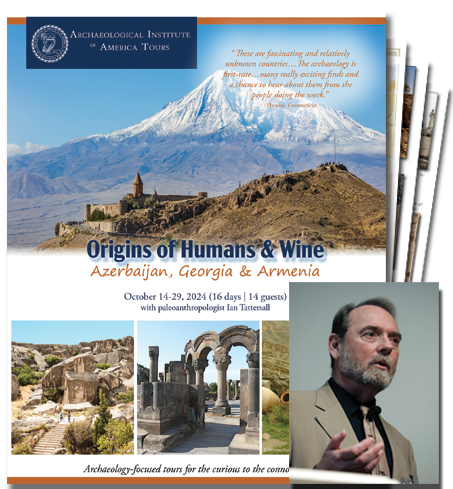Join us for an exciting trip back in time to explore early humankind and the ‘cradle of wine’ in the southern Caucasus. Learn about ancient winemaking techniques and sample the bounty of the region’s vineyards. Explore medieval towns and UNESCO World Heritage Sites, including prehistoric through early Christian complexes. Enjoy Georgia’s famed hospitality, wherein a ‘visitor is considered a gift from God.’ This is a region of extraordinary contrasts, deep history, and cultural diversity.
HIGHLIGHTS:
- Travel and learn with AIA lecturer/host Ian Tattersall, who is both a paleoanthropologist and an oenophile; plus a professional tour manager and local guides
- Visit impressive UNESCO World Heritage Sites: Baku’s Old City, Shirvan Shah Palace complex, and 98-foot-tall Maiden Tower, plus the ancient petroglyphs of Gobustan, in Azerbaijan; Georgia’s Mtskheta; and Armenia’s Echmiadzin and Zvartnots Cathedral
- Learn about and sample wines at five different wineries: Azerbaijan’s ASPI Winery in the Savalan Valley; Georgia’s Tibaani Vineyards, Chateau Mukhrani winery, and a winery specializing in quevri-made wines; and Armenia’s Areni Winery near the ancient Areni-1 cave complex
- Explore a variety of fascinating prehistoric through early Christian sites, including:
- Dmanisi, a medieval town under which were found five 1.8-million-year-old Homo skulls
- The cave complex of Areni-1, where a 6,000-year-old winery was discovered
- Several of Georgia’s oldest churches, including Bolnisi’s Sioni Church, Tbilisi’s 6th-century Anchiskhati Basilica, and Mtshketa’s 11th-century Svetitskhoveli Cathedral
- Impressive monasteries, including 6th-century Jvari, with one of the country’s earliest (and one of its finest) churches
- Enjoy a large feast, known as a supra, by experiencing a Georgian Table covered with plates of delicacies balanced on top of each other plus countless toasts
Tour Prices per person (14 nights):
Double Occupancy (12-14 participants) $9,495
Double Occupancy (10-11 participants) $9,895
Single Supplement (limited availability) $1,655
A single supplement will be charged when requested or required.
With fewer than 10 participants, a small group surcharge may be added.
To reserve your space using the online form, click here.
For reservations or questions, please email us at aia@studytours.org (and include your full name) or call us toll-free at (800) 748-6262 (toll: 603-756-2884).
